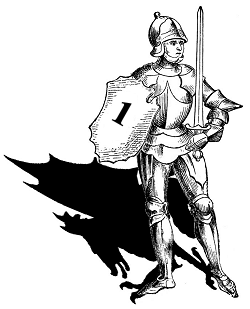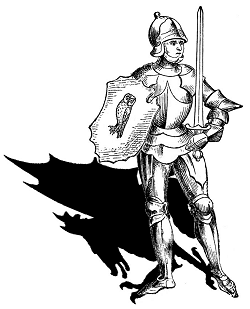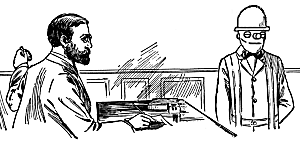 This is the first of four posts about key ideas from my book The Shadow of Consciousness. We start with the so-called Easy Problem, about how the human mind does its problem-solving, organism-guiding thing. If robots have Artificial Intelligence, we might call this the problem of Natural Intelligence.
This is the first of four posts about key ideas from my book The Shadow of Consciousness. We start with the so-called Easy Problem, about how the human mind does its problem-solving, organism-guiding thing. If robots have Artificial Intelligence, we might call this the problem of Natural Intelligence.
I suggest that the real difficulty here is with what I call inexhaustible problems – a family of issues which includes non-computability, but goes much wider. For the moment all I aim to do is establish that this is a meaningful group of problems and just suggest what the answer might be.
It’s one of the ironies of the artificial intelligence project that Alan Turing both raised the flag for the charge and also set up one of the most serious obstacles. He declared that by the end of the twentieth century we should be able to speak of machines thinking without expecting to be contradicted; but he had already established, in his solution to the Halting Problem, that certain questions are unanswerable by the Universal Turing Machine and hence by the computers that approximate it. The human mind, though, is able to deal with these problems: so he seemed to have identified a wide gulf separating the human and computational performances he thought would come to be indistinguishable.
Turing himself said it was, in effect, merely an article of faith that the human mind did not ultimately, in respect of some problems, suffer the same kind of limitations as a computer; no-one had offered to prove it.
Non-computability, at any rate, was found to arise for a large set of problems; another classic example being the Tiling Problem. This relates to sets of tiles whose edges match, or fail to match, rather like dominoes. We can imagine that the tiles are square, with each edge a different colour, and that the rule is that wherever two edges meet, they must be the same colour. Certain sets of tiles will fit together in such a way that they will tile the plane: cover an infinite flat surface: others won’t – after a while it becomes impossible to place another tile that matches. The problem is to determine whether any given set will tile the plane or not. This turns out unexpectedly to be a problem computers cannot answer. For certain sets of tiles, an algorithmic approach works fine; those that fail to tile the plain quite rapidly, and those that do so by forming repeating patterns like wallpaper. The fly in the ointment is that some elegant sets of tiles will cover the plane indefinitely, but only in a non-repeating, aperiodic way; when confronted with these, computational processes run on forever, unable to establish that the pattern will never begin repeating. Human beings, by resorting to other kinds of reasoning, can determine that these sets do indeed tile the plane.
Roger Penrose, who designed some examples of these aperiodic sets of tiles, also took up the implicit challenge thrown down by Turing, by attempting to prove that human thought is not affected by the limitations of computation. Penrose offered a proof that human mathematicians are not using a knowably sound algorithm to reach their conclusions. He did this by providing a cunningly self-referential proposition stated in an arbitrary formal algebraic system; it can be shown that the proposition cannot be proved within the system, but it is also the case that human beings can see that in fact it must be true. Since all computers are running formal systems, they must be affected by this limitation, whereas human beings could perform the same extra-systemic reasoning whatever formal system was being used – so they cannot be affected in the same way.
Besides the fact that the human mind is not restricted to a formal system, Penrose established that it out-performs the machine by looking at meanings; the proposition in his proof is seen to be true because of what it says, not because of its formal syntactical properties.
Why is it that machines fail on these challenges, and how? In all these cases of non-computability the problem is that the machines start on processes which continue forever. The Turing Machine never halts, the tiling patterns never stop getting bigger – and indeed, in Penrose’s proof the list of potential proofs which has to examined is similarly infinite. I think this rigorous kind of non-computability provides the sharpest, hardest-edged examples of a wider and vaguer family of problems arising from inexhaustibility.
A notable example of inexhaustibility in the wider sense is the Frame Problem, or at least its broader, philosophical version. In Dennett’s classic exposition, a robot fails to notice an important fact; the trolley that carries its spare battery also bears a bomb. Pulling out the trolley has fatal consequences. The second version of the robot looks for things that might interfere with its safely regaining the battery, but is paralysed by the attempt to consider every logically possible deduction about the consequences of moving the trolley. A third robot is designed to identify only relevant events, but is equally paralysed by the task of considering the relevance of every possible deduction.
This problem is not so sharply defined as the Halting Problem or the Tiling Problem, but I think it’s clear that there is some resemblance; here again computation fails when faced with an inexhaustible range of items. Combinatorial explosion is often invoked in these cases – the idea that when you begin looking at permutations of elements the number of combinations rises exponentially, too rapidly to cope with: that’s not wrong, but I think the difficulty is deeper and arises earlier. Never mind combinations: even the initial range of possible elements for the AI to consider is already indefinably large.
Inexhaustible problems are not confined to AI. I think another example is Quine’s indeterminacy of translation. Quine considered the challenge of interpreting an unknown language by relating the words used to the circumstances in which they were uttered. Roughly speaking, if the word “rabbit” is used exactly when a rabbit is visible, that’s what it must mean; and through a series of observations we can learn the whole language. Unfortunately, it turns out that there is always an endless series of other things which the speaker might mean. Common sense easily rejects most of them – who on earth would talk about “sets of undetached rabbit parts”? – but what is the rigorous method that explains and justifies the conclusions that common sense reaches so easily? I said this was not an AI problem, but in a way it feels like one; arguably Quine was looking for the kind of method that could be turned into an algorithm.
In this case, we have another clue to what is going on with inexhaustible problems, albeit one which itself leads to a further problem. Quine assumed that the understanding of language was essentially a matter of decoding; we take the symbols and decode the meaning, process the meaning and recode the result into a new set of symbols. We know now that it doesn’t really work like that: human language rests very heavily on something quite different; the pragmatic reading of implicatures. We are able to understand other people because we assume they are telling us what is most relevant, and that grounds all kinds of conclusions which cannot be decoded from their words alone.
A final example of inexhaustibility requires us to tread in the footsteps of giants; David Hume, the Man Who Woke Kant, discovered a fundamental problem with cause and effect. How can we tell that A causes B? B consistently follows A, but so what? Things often follow other things for a while and then stop. The law of induction allows us to conclude that if B is regularly followed by A, we can conclude that it will go on doing so. But what justifies the law of induction? After all, many potential inductions are obviously false. Until quite recently a reasonable induction told us that Presidents of the United States were always white men.
Dennett pointed out that, although they are not the same, the Frame Problem and Hume’s problem have a similar feel. They appear quite insoluble, yet ordinary human thought deals with them so easily it’s sometimes hard to believe the problems are real. It’s hard to escape the conclusion that the human mind has a faculty which deals with inexhaustible problems by some non-computational means. Over and over again we find that the human approach to these problems depends on a grasp of relevance or meaning; no algorithmic approach to either has been found.
So I think we need to recognise that this wider class of inexhaustible problem exists and has some common features. Common features suggest there might be a common solution, but what is it? Cutting to the chase, I think that in essence the special human faculty which lets us handle these problems so readily is simply recognition. Recognition is the ability to respond to entities in the world, and the ability to recognise larger entities as well as smaller ones within them opens the way to ‘seeing where things are going’ in a way that lets us deal with inexhaustible problems.
As I suggested recently, recognition is necessarily non-algorithmic. To apply rules, we need to have in mind the entities to which the rules apply. Unless these are just given, they have to be recognised. If recognition itself worked on the basis of rules, it would require us to identify a lower set of entities first – which again, could only be done by recognition, and so on indefinitely.
In our intellectual tradition, an informal basis like this feels unsatisfying, because we want proofs; we want something like Euclid, or like an Aristotelian syllogism. Hume took it that cause and effect could only be justified by either induction or deduction; what he really needed was recognition: recognition of the underlying entity of which both cause and effect are part. When we see that B is the result of A, we are really recognising that B is A a little later and transformed according to the laws of nature. Indeed, I’d argue that sometimes there is no transformation: the table sitting quietly over there is the cause of its own existence a few moments later.
As a matter of fact I claim that while induction relies directly on recognising underlying entities, even logical deduction is actually dependent on seeing the essential identity, under the laws of logic, of two propositions.
Maybe you’re provisionally willing to entertain the idea that recognition might work as a basis for induction, sort of. But how, you ask, does recognition deal with all the other problems? I said that inexhaustible problems call for mastery of meaning and relevance: how does recognition account for those? I’ll try to answer that in part 2.




